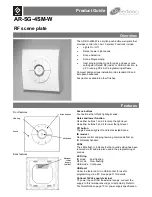
RCVDL56DPFL/SP, RCV56DPFL/SP, and RCV336DPFL/SP Designer’s Guide
4-22
1119
Function 30:
RLSD Drop Out Timer
Acc. Method: 1
Addr.: 270h, 271h
V.32 bis, V33, V17, V29, V27, V.26 and V.21 channel 2
Address 270, 271 holds the value for a 16-bit counter which decrements at a baud interval when energy is removed from
RXA. When the counter reaches 0000, RLSD turns off. The count down may be observed in addresses 389h (value from
address 271h) and 388h (value from address 270h). The value in address 271h (MSB), 270h (LSB) may be changed
anytime after RLSD = 1. The default time may be read in address 271h, 270h after RLSD = 1. See Table 1-2 for baud rates
of individual modes. By prolonging the RLSD on-off time, the MDP can be kept in a freeze mode which can be used to
bridge long dropouts. Dropouts of several seconds can be bridged by extending this timer. The default RLSD on-off time for
V.32 bis is approximately 500 ms. Note that in V.32 bis mode, it is possible for the receiver to lock onto the local transmit
signal when the received signal is lost. (See the DISDET description in Table 3-1.)
V.22 bis, V.22, Bell 212/1200
The 8-bit value in address 270h controls the RLSD on-off time. The value counts down to 0 in address 388h. Once this value
starts to decrement, after the signal has been removed from RXA, the host may continuously write a large value in address
388, not allowing the counter to decrement, in order to prolong the RLSD on-off time if the 8-bit counter is not sufficient.
This, however, requires the host to monitor address 388 during the connection until it starts to decrement.
The 8-bit value in address 271h controls the time the MDP will wait for energy to return after RLSD has turned off. This value
is loaded into address 389h and starts to count up until it reaches a value of 63h. The default value in address 271h is 0
which gives the maximum freeze time of 63h bauds. After RLSD = 0, the host may continuously write 00 in address 389h,
not allowing the counter to increment, in order to prolong the freeze time. Both addresses 27h1 and 270h may be written to
after RLSD = 1.
Function 31:
RLSD Turn-On Threshold (RLSD_ON)
Acc. Method: 2
Addr.: 135h, 134h
Function 32:
RLSD Turn-Off Threshold (RLSD_OFF)
Acc. Method: 2
Addr.: 137h, 136h
RLSD Threshold Offset
Acc. Method: 2
Addr.: 139h, 138h
RLSD Overwrite Control
Acc. Method: 1
Addr.: 10Dh:2
Extended RTH Control
Acc. Method: 1
Addr.: 10Dh:6
A control bit (10Dh:2) enables or disables the over-writing of the RLSD thresholds by the MDP's own default threshold table
[0 = overwriting enabled (default); 1 = overwriting disabled]. The default state is initialized only by power on or a soft reset.
The RLSD thresholds are loaded into memory locations RLSD_ON and RLSD_OFF. During the Idle mode initialization, the
2-byte value stored in RLSD_ON is used as the RLSD on threshold. When the MDP is in Data mode, the 2-byte RLSD_OFF
value is used for the RLSD off threshold.
During reset, the respective thresholds for V.32 bis 14400 bps are loaded into RLSD_ON and RLSD_OFF as initial values.
After reset, the host may then alter these values using the following procedure:
1. Set 10Dh:2 (to prevent custom values from being overwritten by default values).
2. Load in the custom RLSD values.
3. Set
NEWC.
Note:
the thresholds can be over-written at any time, but this method ensures that the first connection after a NEWC uses
the correct value of ON threshold.
Extended RLSD Threshold Selection;
The Extended RTH bit (XRTH) (10Dh:6) controls the reduction of RLSD thresholds by approximately 5 dBm [0 = disables
reduction (default); 1 = enables reduction]. If XRTH is a 1, RTH must be reset to 0. This extended RLSD threshold method
affects all configurations while preserving the hysteresis.
The amount of threshold reduction (offset) can be controlled manually by the host writing a 16-bit offset value into address
139, 138. For example, this offset is useful for compensating for any loss or gain that may be introduced by the DAA/hybrid
used. Note that if a negative offset is wanted, then the twos complement number should be entered. The maximum amount
of offset that can safely be subtracted is 900h (F700h, 2s complement).
Summary of Contents for RC336DPFL
Page 193: ...INSIDE BACK COVER NOTES ...
















































